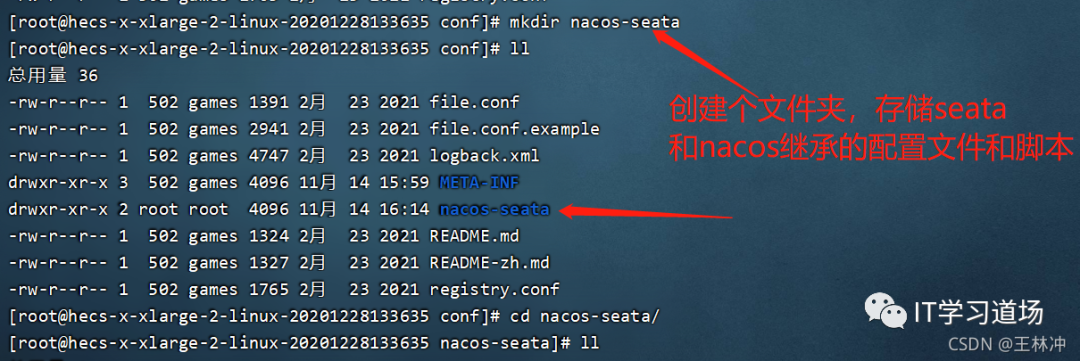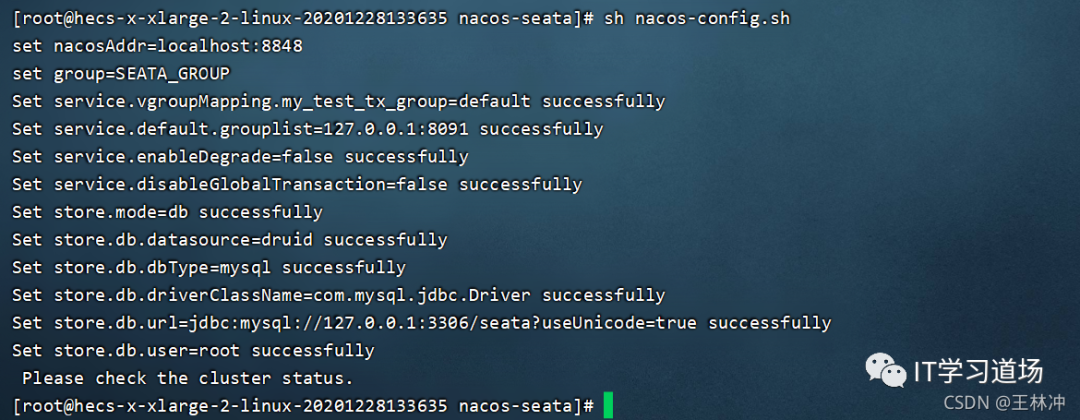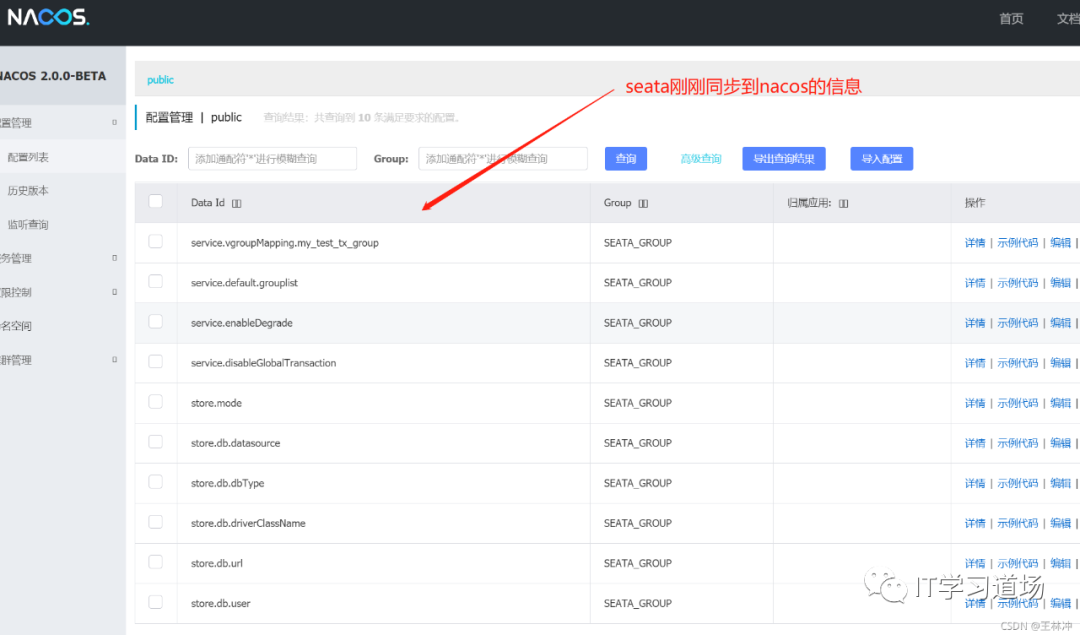seata部署文档
上传压缩包
上传压缩包 seata-server-1.4.0.tar.gz 到linux服务器 opt 下
解压
解压 seata-server-1.4.0.tar.gz
tar -zxvf seata-server-1.4.0.tar.gz解压后的目录是 seata
seata的配置文件修改
修改 opt/seata/conf 下的 file.conf 和 registry.conf
file.conf
## transaction log store, only used in seata-serverstore {## store mode: file、db、redismode = "db"## database store propertydb {## the implement of javax.sql.DataSource, such as DruidDataSource(druid)/BasicDataSource(dbcp)/HikariDataSource(hikari) etc.datasource = "druid"## mysql/oracle/postgresql/h2/oceanbase etc.dbType = "mysql"driverClassName = "com.mysql.jdbc.Driver"url = "jdbc:mysql://10.100.232.173:3306/seata"user = "root"password = "123456"minConn = 5maxConn = 100globalTable = "global_table"branchTable = "branch_table"lockTable = "lock_table"queryLimit = 100maxWait = 5000}}
registry.conf
registry {# file 、nacos 、eureka、redis、zk、consul、etcd3、sofatype = "nacos"loadBalance = "RandomLoadBalance"loadBalanceVirtualNodes = 10nacos {application = "seata-server"serverAddr = "10.100.232.172:8848"group = "SEATA_GROUP"namespace = ""cluster = "default"username = "nacos"password = "nacos"}}
创建seata的数据库
在mysql上创建一个 mscm-seata-test 的数据库(你可以根据自己的喜好取名字),执行如下脚本,把表同步进去
-- -------------------------------- The script used when storeMode is 'db' ---------------------------------- the table to store GlobalSession dataCREATE TABLE IF NOT EXISTS `global_table`(`xid` VARCHAR(128) NOT NULL,`transaction_id` BIGINT,`status` TINYINT NOT NULL,`application_id` VARCHAR(32),`transaction_service_group` VARCHAR(32),`transaction_name` VARCHAR(128),`timeout` INT,`begin_time` BIGINT,`application_data` VARCHAR(2000),`gmt_create` DATETIME,`gmt_modified` DATETIME,PRIMARY KEY (`xid`),KEY `idx_gmt_modified_status` (`gmt_modified`, `status`),KEY `idx_transaction_id` (`transaction_id`)) ENGINE = InnoDBDEFAULT CHARSET = utf8;-- the table to store BranchSession dataCREATE TABLE IF NOT EXISTS `branch_table`(`branch_id` BIGINT NOT NULL,`xid` VARCHAR(128) NOT NULL,`transaction_id` BIGINT,`resource_group_id` VARCHAR(32),`resource_id` VARCHAR(256),`branch_type` VARCHAR(8),`status` TINYINT,`client_id` VARCHAR(64),`application_data` VARCHAR(2000),`gmt_create` DATETIME(6),`gmt_modified` DATETIME(6),PRIMARY KEY (`branch_id`),KEY `idx_xid` (`xid`)) ENGINE = InnoDBDEFAULT CHARSET = utf8;-- the table to store lock dataCREATE TABLE IF NOT EXISTS `lock_table`(`row_key` VARCHAR(128) NOT NULL,`xid` VARCHAR(96),`transaction_id` BIGINT,`branch_id` BIGINT NOT NULL,`resource_id` VARCHAR(256),`table_name` VARCHAR(32),`pk` VARCHAR(36),`gmt_create` DATETIME,`gmt_modified` DATETIME,PRIMARY KEY (`row_key`),KEY `idx_branch_id` (`branch_id`)) ENGINE = InnoDBDEFAULT CHARSET = utf8;
seata配置信息数据上传到nacos
创建nacos-seata文件夹,存储nacos的脚本和配置

创建 nacos-config.sh,和 nacos-config.txt
我的在一个目录下的,一会儿改下nacos-config.sh的扫描nacos-config.txt路径就行

nacos-config.txt内容
#我的只是mysql的DB模式,就需要这些,你若是用其他的,可以保留其他配置service.vgroupMapping.my_test_tx_group=defaultservice.default.grouplist=127.0.0.1:8091service.enableDegrade=falseservice.disableGlobalTransaction=falsestore.mode=dbstore.db.datasource=druidstore.db.dbType=mysqlstore.db.driverClassName=com.mysql.jdbc.Driverstore.db.url=jdbc:mysql://10.100.232.173:3306/seata?useUnicode=truestore.db.user=rootstore.db.password=123456store.db.minConn=5store.db.maxConn=30store.db.globalTable=global_tablestore.db.branchTable=branch_tablestore.db.queryLimit=100store.db.lockTable=lock_tablestore.db.maxWait=5000
nacos-config.sh内容:
#!/usr/bin/env bash# Copyright 1999-2019 Seata.io Group.## Licensed under the Apache License, Version 2.0 (the "License");# you may not use this file except in compliance with the License.# You may obtain a copy of the License at、## http://www.apache.org/licenses/LICENSE-2.0## Unless required by applicable law or agreed to in writing, software# distributed under the License is distributed on an "AS IS" BASIS,# WITHOUT WARRANTIES OR CONDITIONS OF ANY KIND, either express or implied.# See the License for the specific language governing permissions and# limitations under the License.while getopts ":h:p:g:t:u:w:" optdocase $opt inh)host=$OPTARG;;p)port=$OPTARG;;g)group=$OPTARG;;t)tenant=$OPTARG;;u)username=$OPTARG;;w)password=$OPTARG;;?)echo " USAGE OPTION: $0 [-h host] [-p port] [-g group] [-t tenant] [-u username] [-w password] "exit 1;;esacdoneif [[ -z ${host} ]]; thenhost=localhostfiif [[ -z ${port} ]]; thenport=8848fiif [[ -z ${group} ]]; thengroup="SEATA_GROUP"fiif [[ -z ${tenant} ]]; thentenant=""fiif [[ -z ${username} ]]; thenusername=""fiif [[ -z ${password} ]]; thenpassword=""finacosAddr=$host:$portcontentType="content-type:application/json;charset=UTF-8"echo "set nacosAddr=$nacosAddr"echo "set group=$group"failCount=0tempLog=$(mktemp -u)function addConfig() {curl -X POST -H "${contentType}" "http://$nacosAddr/nacos/v1/cs/configs?dataId=$1&group=$group&content=$2&tenant=$tenant&username=$username&password=$password" >"${tempLog}" 2>/dev/nullif [[ -z $(cat "${tempLog}") ]]; thenecho " Please check the cluster status. "exit 1fiif [[ $(cat "${tempLog}") =~ "true" ]]; thenecho "Set $1=$2 successfully "elseecho "Set $1=$2 failure "(( failCount++ ))fi}count=0# 刚刚$(dirname "$PWD")/nacos-seata/nacos-config.txt所在的路径,你的不一样,可以自己修改for line in $(cat $(dirname "$PWD")/nacos-seata/nacos-config.txt | sed s/[[:space:]]//g); do(( count++ ))key=${line%%=*}value=${line#*=}addConfig "${key}" "${value}"doneecho "========================================================================="echo " Complete initialization parameters, total-count:$count , failure-count:$failCount "echo "========================================================================="if [[ ${failCount} -eq 0 ]]; thenecho " Init nacos config finished, please start seata-server. "elseecho " init nacos config fail. "fi
然后给nacos-config.sh执行权限即可,再执行如下命令:
sh nacos-config.sh

看下nacos

管理脚本
切换到/opt/seata的目录下,创建 seata-start.sh 和 seata-stop.sh 和 kill-process.sh
seata-start.sh 内容
nohup ./bin/seata-server.sh -p 8091 > ./logs/seata.log 2>&1 &kill-process.sh 内容
#!/bin/sh#根据进程名杀死进程if [ $# -lt 1 ]thenecho "缺少参数:procedure_name"exit 1fiPROCESS=`ps -ef|grep $1|grep -v grep|grep -v PPID|awk '{ print $2}'`for i in $PROCESSdoecho "Kill the $1 process [ $i ]"kill -9 $idone
kill-process.sh 内容
./kill-process.sh seataseata-stop.sh 内容
#杀死进程名字 = seata 的进程
./kill-process.sh seata
再创建一个seata-restart.sh的脚本,处理seata的重启,里面就是调用 seata-stop.sh,再调用 seata-start.sh而已;
seata-restart.sh:
#执行停止脚本
./seata-stop.sh
echo "seata正在启动......"
#执行启动脚本
./seata-start.sh
# $?代表上个命令执行状态,如果 = 0,则说明执行成功
if [ $? -eq 0 ];then
sleep 5s
echo "seata启动成功......"
else
echo "seata启动失败......"
fi
分别给这几个sh脚本执行权限,就可以直接执行对应脚本,来启动,停止,重启seata了
seata开机自启
上面的脚本是手动执行,开机不能自启 ,每次宕机,都要手动重启seata,太麻烦
给seata设置开机自启
1)cd etc/init.d 进入目录
2)创建文件seata
#!/bin/bash##chkconfig: 345 63 37#description: seata#processname: seataexport JAVA_HOME=/opt/jdk8/jdk1.8.0_333export CLASSPATH=.:$JAVA_HOME/lib/dt.jar:$JAVA_HOME/lib/tools.jarexport PATH=$PWD/bin:$JAVA_HOME/bin:$PATHSEATA_HOME=/opt/seatacase $1 instart)nohup sh $SEATA_HOME/bin/seata-server.sh -p 8091 -h 10.100.232.171 > seata.out 2>&1 &echo $! > $SEATA_HOME/bin/seata.pidecho "seata is started";;stop)pid=`ps -ef|grep seata |grep -v grep|grep -v PPID|awk '{ print $2}'`kill -9 $pidecho "seata is stopped";;*)echo "start|stop|restart";;esacexit 0
3)给脚本添加权限chmod 755 seata
4)添加服务到开机项 chkconfig --add seata
5)设置为开机启动 chkconfig seata on
6)测试 service seata start






